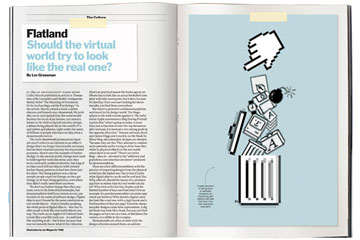
In 1890 an Archaeologist named Henry Colley March published an article in Transactions of the Lancashire and Cheshire Antiquarian Society titled "The Meaning of Ornament: Or Its Archaeology and Its Psychology." In the article, March coined a word, a rather obscure and homely one: skeuomorph. He probably never anticipated that this word would become the focus of an intense 21st century debate in the field of digital-interface design, a debate being played out on the world's PCs and tablets and phones, right under the noses of billions of people who have no idea what a skeuomorph even is.
The term skeuomorph (pronounced skyoo-uh-morf) refers to an element in an object's design that's no longer functionally necessary but has been retained anyway for ornamental purposes. March uses the example of leather thongs. In the ancient world, thongs were used to hold together tools like stone axes; they were eventually rendered obsolete, but long after that you'd still see objects with twisted-leather-thong patterns etched into them just for show. The thong pattern was a skeuomorph: people expected thongs, so they got thongs, or at least thong patterns, even when they didn't really need them anymore.
We don't see leather thongs that often anymore, even in the form of skeuomorphs, but skeuomorphism itself is as current as ever, particularly in the realm of software design. Digital objects aren't bound by the same constraints as real-world objects--that is, broadly speaking, the whole point of digital objects--but they're often made to look like real-world objects anyway. The trash can in Apple's OS X doesn't have to look like a real-life trash can--it could look like anything at all--but it does, because that way we instantly know what it's for. Likewise, there's no practical reason the books app on an iPhone has to look like an actual bookshelf complete with fake wood grain, but it does, because it's familiar. Once you start looking for skeuomorphs, you find them everywhere.
But there's a powerful antiskeuomorphism sentiment in the design world. The blogosphere is rife with screeds against it. The influential Apple commentary blog Daring Fireball reports that "what's going on today is more than just a rejection of over-the-top skeuomorphic textures; it is instead a very strong push in the opposite direction." Veteran software developer James Higgs put it starkly on the Made by Many blog: skeuomorphic designs are obsolete "because they are lies. They attempt to comfort us (to patronize us) by trying to show how they relate to physical objects in the real world when there is no need." There's an entire blog--skeu.it--devoted to the "arbitrary and gratuitous user interface decisions" produced by skeuomorphism.
